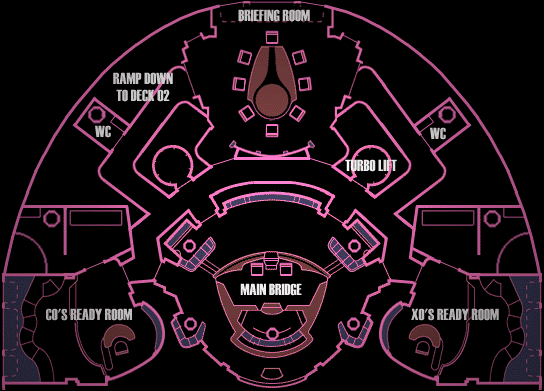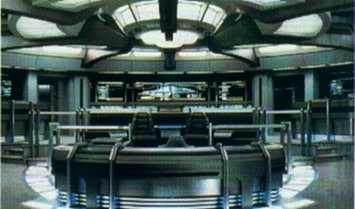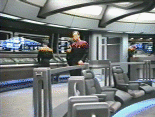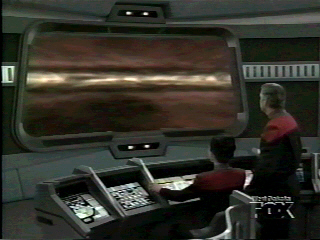|
|
|

Deck One is the command center of the ship. It is located at the top of the saucer section & houses the Bridge, ready rooms & the conference room. The Bridge is detachable & contains:
Navigational deflector:
foreward Eng. hull, ventral of saucer
aux. foreward dorsal saucer
Conn:
Autopilot
attitude control
nav. computer, main & backup
inertial dampeners, main & backup
Comm:
type 8 systems
emergency comm channel

Master Systems
Display




Bridge Stations:
Command
The Central area of the bridge provides
seating and information for the Commanding Officer, and Executive Officer.
All bridge Operations authority rest with the Commanding Officer on the
bridge at that time, (usually the Captain, or XO, 2nd officer or OtherRanking
Commissioned Officer [in that order]). The Commanding Officer is responsible
for execution of Starfleet Orders and Policy, as well as for interpretation
and compliance with Federation law and diplomatic directives. As such a
Commanding Officer is directlyresponsible for the performance of the ship.
The Command seating has information displays, which provide the CO, and XO (or other officer in shift command at the time) with all information available to the different stations around the bridge, and simplified Conn and Ops controls. Upon a key or vocal command, the Commanding Officer can use these controls to override the basic operation of the spacecraft. Such overrides are generally reserved for emergency situations.
Normal operating rules require a shift
Command Officer to be on duty at all times,
although the presence of the other
personnel is optional, depending on the specific mission requirements.
Flight COntrol (Conn)
CONN, sometimes called Flight Control
or Helm, is located at the front of the bridge, giving a clear and unhindered
view of the view screen. The Conn is responsible for the actual piloting
and navigation of the starship. Although these are heavily automated functions,
their criticality demands a living
officer to oversee these operations at all times.
During impulse powered spaceflight,
Conn is responsible for monitoring realistic effects as well as inertial
damping system status. In the event that a requested manoeuvre exceeds
the capacity of the inertial dampening system, the computer will request
Conn to
modify the flight plan to bring it
within permitted performance envelope. During Alert status, flight rules
permit Conn to specify manoeuvres that are potentially dangerous to the
crew or the spacecraft.
Warp flight operating rules require
Conn to monitor subspace field geometry in parallel with the Engineering
department. During warp flight, the Conn station is continually updated
by long-range sensor data, allowing automatic course corrections to adjust
for minor
variations in the density of interstellar
medium.
Because of the criticality of Conn in starship operations, Conn is connected to a dedicated backup flight subproccesor to provide for manual flight control. This equipment package includes emergency navigation sensors.
There are 4 major areas of responsibility
for the Conn's Officer.
1. Navigational reference/course plotting
2. Supervision of automatic flight
operations
3. Manual flight operations
4. Position verification
Operations (Ops)
OPS is traditionally stationed at the
front of the bridge with Conn. However, the
Intrepid style bridge moved Ops to
a larger and more advanced station. This
required a separate styled station
form original forms. OPS can now be found
on the top right, (when looking from
the view screen) of the bridge.
Many shipboard operations involve scheduling
resources or hardware (such as
power or the use of sensors) that affect
a number of departments. In many such
cases, it is common for various
operations to present conflicting requirements.
It is the responsibility of the
Ops officer to co-ordinate such activities so that
mission goals are not jeopardised.
Having a crew member in this decision-making loop is of critical
importance because of the wide range of unpredictable situations
with which a starship must deal.
Most routine scheduling and resource
allocation is done automatically by the
Ops program. This frees the Ops Officer
from routine activity, leaving him/her
able to concentrate on decisions
beyond the scope of the artificial intelligence
software. The level of these
decision filter programs can be set by the Ops
officer, and also varies with
the current Alert status of the ship.
During crisis situations and reduced
power mode operations, Ops is
responsible for supervision of power
allocation in co-ordination with the
Engineering department. Load
shedding of nonessential power usage in such
situations is based on spacecraft
survival factors and mission priorities.
The Ops officer is also responsible
for providing general status information to
the main computer, which is then
made available to all departments and
personnel. Ops routes specific
information to specific departments to inform
them of anticipated changes and requirements
that may affect their operations.
Ops also maintains a watch on
key engineering functions
Security & Tactical
Located in the mirror position to the
Ops Station is Security. This is also the
base for Tactical operations.
The main security Station is manned
by a Security, or Tactical Officer,
although a separate single tactical
console is located directly behind the
Command chairs. This separate tactical
console is for use in conflict
situations to allow the freedom of
both the Security and Tactical operators on
the bridge.
Under normal conditions the security
console is manned by Tactical, and
Security is run from the main Security
Office. Under Yellow, and Red Alert
mode operations the Security station
is manned by a Security Officer, and
Tactical takes control of the
Tactical Station behind the Command chairs. The
U.S.S. Bismarck also has a Marine
detachment, who work as extra officers
for Security when ship board
functions are taking place, but take command on
away team missions in accordance
with Starfleet Policy.
Shipboard Defense Functions
Under normal conditions, cruise
mode, security does not man a position on
the bridge, instead conducting
it's ship wide security from the Security
Department Offices. Here Security controls
the inventory of weapons, Security
team personnel assignments, ranging
from personnel bodyguard's, to key
location guarding. However under
alert conditions Security can be controlled
from the main security station
on the bridge.
Starship Defense Functions
The very survival of the ship
will often rest in the hands of the Tactical officer,
and his/her performance of operations
in hazardous situations. Tactical
co-ordinates with Conn and Ops
in all situations involving external hazards.
Guidance and navigation information,
targeting data, and external
communications are networked
through these three stations, providing
expanded options for dealing
with the unknown as they present themselves.
Tactical also has the latest defence
technology available to it for defence,
phasers, photon and quantum torpedoes,
as well as tricobalt devices, and the
latest development in shield
technology. Under normal conditions, Tactical
mans the Security Station on the bridge,
performing ship wide tactical
analysis. However under Yellow and
Red Alert conditions Tactical moves to
the Tactical Station located
behind the Command chairs.
Both Security, Tactical and Marine
Officers work closely together in providing
ship wide security, and can perform
each others task, if a crisis situation
requires this.
Engineering
Located at the front left (from view
screen looking towards the Command chairs) of
the bridge, the Engineering Station
duplicates the primary status display in main
Engineering. These displays include
warp/impulse propulsion systems, as well as
other major subsystems. The purpose
of this station is to permit the Chief Engineer
to maintain supervision over engineering
systems while on the bridge, as well as a
back up for engineering operations
should Main Engineering be compromised, and
unavailable for system use. This is
Station is particularly critical during Alert
situations that may require the Chief
Engineer's presence on the bridge while
simultaneously requiring that officer
to maintain a close watch over the status of key
systems. During most cruise mode operations
it is the responsibility of the Ops
officer to monitor these systems through
the OPS station for the bridge.
Although this Station is normally configured
for passive system display, priority
access by the Chief Engineer or senior
staff can provide full control of virtually all
engineering systems.
The console is linked to the engineering
system through the bridge's dedicated
optical data network trunk, but an
additional measure of redundancy is provided by
the dedicated optical hardlines, which
permit direct control of key systems in the
event of a major control systems failure.
In such a case, the main computer cores
would be assumed to be unavailable
or unreliable, so manual control of systems
would be enabled with support from
the bridge subprocessor.
In full enabled mode, this station is
capable of individually addressing each control
and servo device in all propulsion
systems (subject to safety restrictions), giving the
Chief Engineer enormous flexibility
to reconfigure system operations in response to
unforeseen situations.
Science
On the opposite side to the Engineering,
Station the Science Station can be found.
This station is used to provide real-time
scientific data to command personnel.
During normal conditions this
station is not manned 24 hours, however under Yellow
and Red Alert conditions the
Chief Science Officer, or other available Science Officer
will take command of this station.
The Science Station is generally configured
for independent operations, allowing the
Science Department to conduct operations
on the Science Deck. Direct links
provide Tactical, Conn, and Ops with
scientific data. During alert status, the Science
Station has priority access to sensor
array, if necessary overriding ongoing science
department operations.
In some cases, the Science Station
is used by personnel attached to secondary
missions including researchers,
and mission specialists.
Science Station Functions
- The ability to provide access
to sensors and interpretative software for primary
mission and command intelligence requirements.
- The ability to act as a command
post for co-ordination of activities of various
science laboratories and monitoring
secondary mission status.
- The ability to reconfigure
and recalibrate sensor systems at a moments notice for
specific command intelligence
requirements.